
- Homepage
- Material
- Bone China (7)
- Brass (6)
- Brass, Porcelain (3)
- Bronze (2)
- Ceramic (17)
- Ceramic & Porcelain (34)
- Ceramic / Porcelain (25)
- Ceramic / Pottery (4)
- Ceramic, Porcelain (40)
- China / Porcelain (16)
- Glass (3)
- Metal (8)
- Ormolu (2)
- Porcelain (1140)
- Porcelain / China (125)
- Porcelain, Cut Steel (3)
- Porzellan (4)
- ... (3392)
- Origin
- Packaging
- Subject
- Theme
- Type
- Bowl (20)
- Bowls (14)
- Boxes (15)
- Brooch (21)
- Collector Plate (28)
- Cup & Saucer (27)
- Decorative Plate (23)
- Figurine (258)
- Figurines & Statues (21)
- Lamps (19)
- Painting (14)
- Plaque (41)
- Plate (49)
- Plates (25)
- Plates & Chargers (22)
- Table Lamp (34)
- Trinket Box (16)
- Trio (22)
- Vase (298)
- Vases (30)
- ... (3834)
Ca Mau Shipwreck Cargo Lotus and Flowerhead Tea Bowl c1725
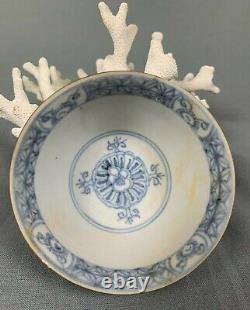
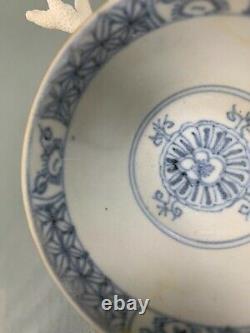
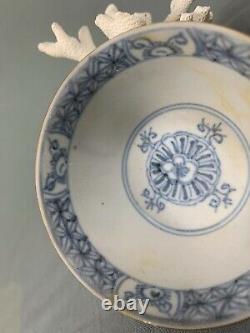
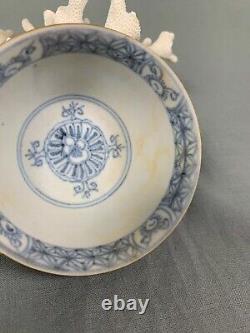
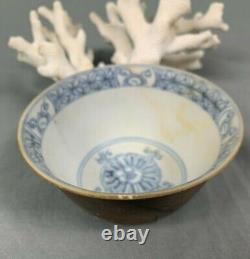
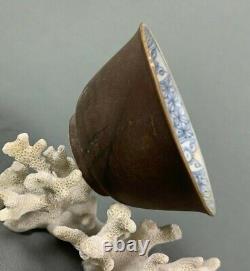
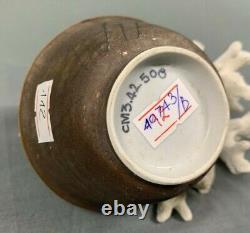
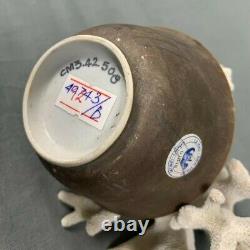


Ca Mau Chinese Shipwreck Porcelain Cargo Blue and White Tea Bowl c1725'Lotus and Flowerhead Pattern' hand painted with the flowerhead encircled by flowering lotus and prunus plants. The exterior in a café-au-lait Batavian glaze. Size: Height: 4.6cm Diameter: 8.4cm Please Note. As these pieces have spent hundreds of years submerged beneath the sea, an overall dulling of the glaze is quite common and more prominent in some examples.
The Journey The Fire and The Salvage The Discovery of the wreck. In June 1998 a news story headlined'Treasure from the bottom of the sea' appeared in a Vietnamese newspaper. Its report was of fishermen working off the southernmost tip of Vietnam whose nets had snagged on a wreck filled with Chinese porcelain. They soon found that the porcelain was early 18.
Century and saleable and then began the scramble to dredge up as much as possible. The wreck was located ninety nautical miles south of the Ca Mau peninsular which is on the old trade route from Kuangzhou, or Canton as it was known to foreigners, southwards to the Malay archipelago and Jakarta which was then the Dutch trading port known as Batavia. His own account follows on pg 10 of the Sotheby's Amsterdam Catalogue. Two Seasons of Excavations Amazingly, within twelve weeks of the news breaking the team started work.
The wreck was in water thirty two to thirty six metres deep and as a result the divers, who worked in shifts, could only stay down on the excavation site for thirty minutes before having to return to the surface with fourteen minutes in decompression. Some was damaged on impact, but huge quantities had survived resting on the seabed for two hundred and eighty years largely under a protective layer of silt. When the divers had reached the site the seabed was a scene of devastation with torn nets as evidence of the fishermens dredging. The first job for the divers was to set out the whole site with two metre squares of metal rods so that the location of all the recoveries could be mapped.
With the onset of winter diving was suspended in Januray 1999 but restarted in April. Working in the same systematic way, the first task was to remove large quantities of sand which had protected the porcelain, as the sand was cleared it was possible to see how professionally the porcelain had been packed. The tea bowls and saucers had been in pine wood barrels sixty centermetres in diameter, with the saucers set on their sides and nested together in circles, layer upon layer. Being deep in the silt these had escaped the fishermen. All were loaded into plastic baskets to be hauled to the surface. Each basket was labelled with the location in which it had been found. In 1999 a total of 51,500 pieces in good and bad condition were recovered. Once the porcelain had been ferried to the shore it was properly washed and stored in warehouses where it was carefully sorted and all the patterns were photographed and catalogued and Dr Nguyen Dinh Chien prepared the manuscript of the book The Ca Mau Shipwreck which was published in 2002.The museums in Vietnam were also given the opportunity to acquire a comprehensive selection of the porcelain for exhibition as well as the seals and all the artefacts. The rest remained in publish ownership in Vietnam. However, from the shapes and designs of the porcelain it was clear that the main part of the cargo had been made for the European market. As time went by it became clear that it was almost certainly a Chinese ocean going junk. The few remaining timbers were analysed and found to be of Nageia Wallichiana, a broad leaved conifer of the family Podocarpaceae which is a tree widely disperced in the Far East and used in shipbuilding.
In addition all the artefacts found were Chinese. These included bronze bowls, padlocks, boxes, lamps and coins of the Kangxi period as well as an ink stone and crucially two stone carved seals. The route for the junks trading with the Malaysian Archipelago, Java and Sumatra started in Canton and then followed the coast of Vietnam before crossing the Gulf of Thailand. The cause of the wreck also became clear.
The junk was unarmed so presumably expected a peaceful journey on this busy route. For some reason there was a fire on board of such intensity that some of the porcelain was fused together and actually warped from the heat. To achieve this result, the fire must have reached a temperature of 1400 Fahrenheit or 760 centigrade. Also cast iron works were fused together which perhaps indicates the kitchen was the cause of the outbreak. As the fire must have burned for a considerable time presumably the crew and the owner of the seals, Pan Tingcai, had time to escape. The Date of the Wreck and Porcelain There were two indicators of the date. The second was some bronze coins of the reign of the Emperor Kangxi who died in 1722. In addition other blue and white wine cups of exactly the same shape and same decoration bore the marks'Ruo Shen Zhen Cang meaning'In the collection of Ruoshen' a mark normally used during the Kangxi period. Furthermore, many other patterns and the style of painting seems to indicate that the date of the manufacture of the porcelain is early in the reign of Yongzheng. The China Trade in the early 18. Century Tea and coffee had become the rage throughout Europe. Mocha, a port in the Red Sea was the source of most of the coffee which was grown in Ethiopia but China was the supplier of tea.The demand was escalating fast early in the 18. Century and the principal traders were the East India Company of London and the VOC of Amsterdam.
The Cargoes varied but by far the largest expenditure was tea with silk second and then porcelain. The Chinese were reluctant to trade with the West and so to keep control the Europeans were tightly restricted to the port of Canton and trading was at all times difficult. The East India Companies, with their need to satisfy the demand for tea, also had to have in mind that tea drinking demanded porcelain and so most of what they imported in these years was tea wares. Pictures of the period show that cups with handles were not generally in use either for tea or coffee, a fact is borne out by this cargo and the many others of which there are full records. The few cups with handles are relatively tall and narrow and may well have been for chocolate which was a newly fashionable drink.
In addition to the passion for tea there were also said to be fifteen hundred coffee houses in London alone and coffee houses were spread across Europe. In the Ottoman Empire the preference was for coffee which has always and still is often drunk from small bowls and cups. The Armenian traders may well have been aiming to satisfy this demand.
The Ca Mau Shipwreck by Dr Nguyen Dinh Chien Introduction The Ca Mau wreck as first reported on the daily newspaper Tuoi Tre (Youth) on 5 May 1998. Accordingly, the authority of Binh Thuan province had confiscated 32 569 artifacts and 2,4 tones of metal objects recovered illegally by two fishermen from a shipwreck off the coast of Ca Mau province. Informed by the Binh Thuan Culture department, the Vietnam Ministry of Culture and information sent two members of the National Antiquity Council, Dr Nguyen Dinh Chien and associate Professor Nguyen Bich, to the province. Afterward, the recoveries, coded as CM1, were handed over to the Binh Thuan Museum.
Also in May, an excavation of the wreck was organized spontaneously by the Ca Mau Department of Fisheries, but the Ca Mau authority stopped it soon. All the finds coded as CM2, were sent to the Ca Mau Museum. The wreck was located some 90 miles south of Ca Mau Cap, in 36 m of water. Following the decision issued on 22-6-1998 by the Ministry of Culture and Information, The National Museum of Vietnamese History (NMVH) was assigned to cooperate with the Ca Mau Culture Department, The Vietnam Salvage Company (Visal) and other authorities concerned to carry out the survey and excavation. An excavation Committee was set up with Dr Nguyen Dinh Chien (NMVH) as the head and Lam Minh Chau (Visal) as deputy head.The Ca Mau authority also set up a Steering Committee to supervise the excavation and conservation of artifacts. The Ca Mau Museum provided security men to oversee the site and four staffs to the excavation. Visal appointed a diving team of 14 persons who were equipped with helmets attached with video camera, masks, suits, knives, communication systems and oxygen bottles.
Among divers, many had taken part in the excavations of Hon Cau Wreck in 1990 and Hon Dam wreck in 1991. It was provided with necessary facilities, including a crane, two high pressure water pumps, two air pressure pumps, a power generator for underwater video cameras, a land video camera, two still cameras and two intercom equipment's. The excavation was officially commenced when my A departed from Vung Tau on 8-8-1998. On 15-8, the site was marked and the 2m x 2mgrid squares were positioned. A dive control room was set up on deck, where the archeologists and the diving operation director monitored the dives through communication systems and recorded the progress of excavation in their site diaries.In good weather conditions, divers worked in pairs with six shifts per day. Each sack of artifacts hauled up was numbered, desalinated, sorted and packed into baskets.
Each basket was accompanied by information on type, status, divers name, diving shift, time lead seals by staff of the Ca Mau Museum. All baskets were kept in separate compartments, inside sweater holding tanks to present drying before their transfer to shore.
Due to the bad weather conditions, the excavation was halted on 24-1-1999, the second excavation commenced. But for unfavorable weather conditions and technical troubles, it lasted only 24 days (from 20-4 to 7-6-1999) As a result, 51.438 artifacts were recovered, but their poor state revealed that the site had been damaged seriously by fishermen's clandestine intrusions. On 16-10-1999 the excavation had ended and the site was officially closed.The excavation of the Ca Mau Shipwreck was the first project of its kind entirely carried out by the Vietnamese human and financial resources. The Hull Remains As observed, the Ca Mau wreck was heavily damaged by the fire before sinking. The hull was nearly destroyed, therefore, only a few of its structural features had been recorded.
24 m long and almost 8 m across. The remaining section pf a mast, 20cm high by 30cm in diameter was found 10-4m from the bow and 0-5m off the centre. Four beams measured 1.49 x 25cm, 4m x 25cm, 3m x 25cm and 8m x 30cm respectively. The longitudinal planks were 6,5 cm thick and 35cm wide. Both iron and wooden nails were used for fixing them at 25cm intervals. Wood samples have been identified as Kim Giao Nagera Wallichiana (Presl) kuntze, a species found widely in Southern India, Southern China and Southeast Asia.
